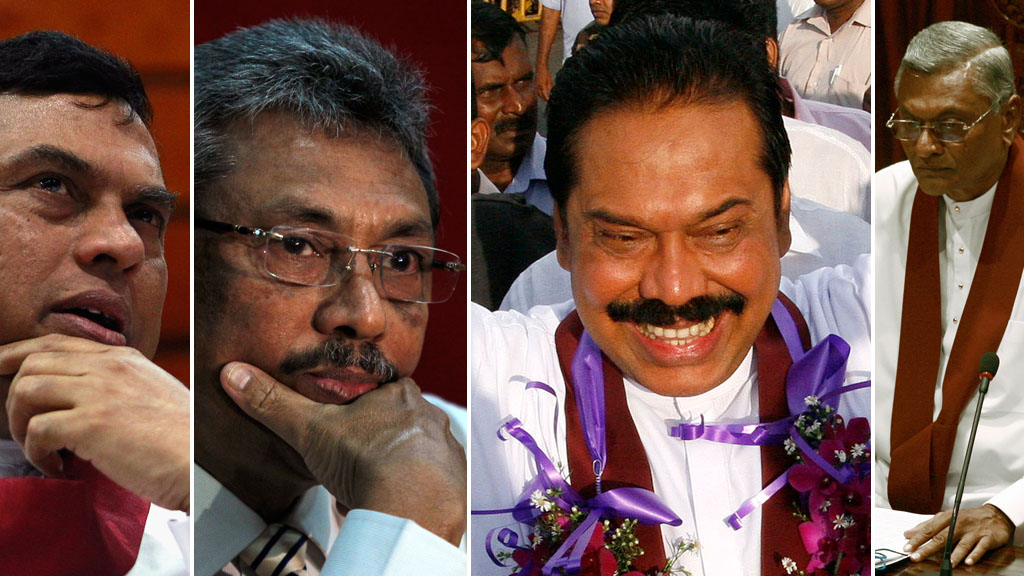The Rajapaksas: who are Sri Lanka’s ruling dynasty?
Sri Lanka’s ruling family are mingling with the Commonwealth’s elite as they host this week’s summit in Colombo. Yet some of them have been accused of war crimes. So who are the Rajapaksas?

Above: the Rajapaksa brothers (left to right: Basil, Gotabaya, Mahinda, Chamal)
President Rajapaksa has been president of Sri Lanka since 2005, having been elected with just over half the country’s votes. Since then his popularity has grown, largely due to the fact that, within four years of having come to power, he had ended the Sri Lankan civil war and had crushed the Tamil Tigers movement.
In 2010, President Rajapaksa secured just shy of 58 per cent of the vote. Since then the Sri Lankan parliament has voted for changes to the constitution which will allow the president to stand for a third term – something that has raised concerns from, among others, UN human rights chief Navi Pillay, of growing authoritarianism from charities and the government’s critics.
Above: President Rajapaksa questioned on human rights by Jonathan Miller of Channel 4 News
Family ties
It is not just Mahinda who benefits from the popularity of the Rajapaksa brand – in total 29 members of Rajapaksa’s extended family hold senior positions within the government, civil service, media and industry, the Sri Lanka Campaign for Peace and Justice says.
According to the group, President Rajapaksa and two of his brothers, Defence Secretary Gotabaya Rajapaksa and Minister of Economic Development Basil Gotabaya, control at least 45 per cent of Sri Lanka’s budget, and manage five government ministries.
Another brother, Chamal Rajapaksa, is the speaker of Sri Lanka’s parliament. The Rajapaksa family has largely been elected into the positions they hold.
Home investment
And it is not just the family that has been helped by the president’s rise to power. His home town, Hambantota, will be host to the Commonwealth Youth Forum.
The tiny fishing village, home to 10,000 people, has benefited from billions upon billions of rupees of investment – including an international conference centre, a 235-acre cinema site, a $1.4bn port and an international cricket stadium (see map, above).
Questions have been raised about the political motivations for the investment – but the president says he is creating a “gateway to Asia” in the south of the country. Hotels, restaurants, a banking square and administrative buildings are planned for the village.
Brothers in arms
Gotabaya Rajapaksa, like Mahinda, allegedly carried out war crimes at the end of Sri Lanka’s civil war. He was appointed defence secretary following his brother’s election to president in 2005.
In July 2011, two years after the end of the civil war, Channel 4 News revealed testimony from two Sri Lankan army soldiers who said the order for the final bloody assault on the Tamil Tigers, which involved the death of thousands of Tamil civilians, had come from Gotabaya.
It was claimed by one of the soldiers that Gotabaya had ordered the army to end the Sri Lankan civil war by “whatever means necessary”. Another soldier said that Gotabaya ordered the execution of two Tamil rebel leaders who had surrendered.
Former Sri Lankan army chief Sarath Fonseka, another senior military figure credited with ending the Tamil Tigers rebellion and who has also been accused of having responsibility for war crimes, has also said that Gotabaya ordered the war crimes.
Read more: CHOGM 2013 - Sri Lanka in the spotlight
In the final weeks of Sri Lanka’s civil war, around 130,000 Tamil civilians were trapped in an increasingly small “no-fire zone” in the north east of Sri Lanka. Evidence revealed by Channel 4 in the film No Fire Zone shows how the army targeted the “safe area” where Tamil civilians were sheltered, despite assurances that it would not. Its attacks appeared to include the targeting of hospitals.
The Tamil Tigers, pioneers of the use of terror tactics such as suicide bombings, have been accused of forcing civilians to stay in the area as human shields.
In the final weeks of the war, the UN has estimated that 40,000 people were killed. These deaths have largely been attributed to the Sri Lankan military – ultimately governed by Mahindra and Gotabaya Rajapaksa.
The Rajapaksas and the Sri Lankan government deny any allegations of war crimes.
Campaigners have accused world leaders, including David Cameron, of boosting Sri Lanka’s regime by attending the Commonwealth heads of government meeting in Colombo. Whether or not this event bolsters the Rajapaksa family’s dominance of power in the country remains to be seen.
-
Latest news
-
Taylor Swift’s new break-up album breaks records3m

-
NHS trust fined £200K for failings that led to death of two mental health patients3m

-
Sunak vows to end UK ‘sick note culture’ with benefit reform3m

-
‘Loose talk about using nuclear weapons is irresponsible and unacceptable’, says head of UN’s nuclear watchdog3m

-
‘There wasn’t an Israeli attack on Iran,’ says former adviser to Iran’s nuclear negotiations team7m

-




